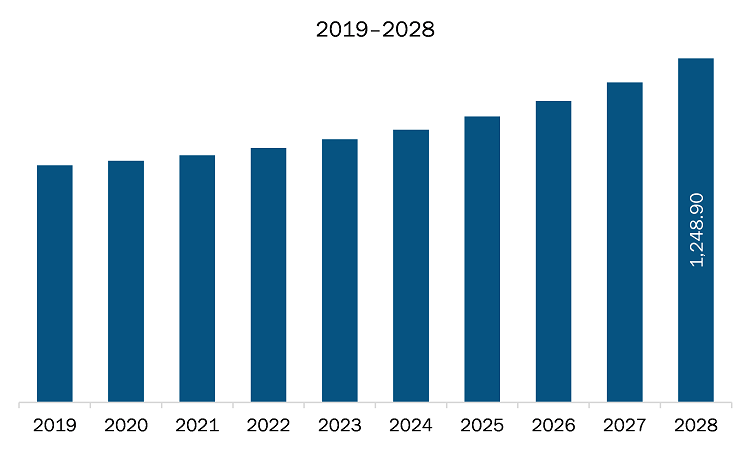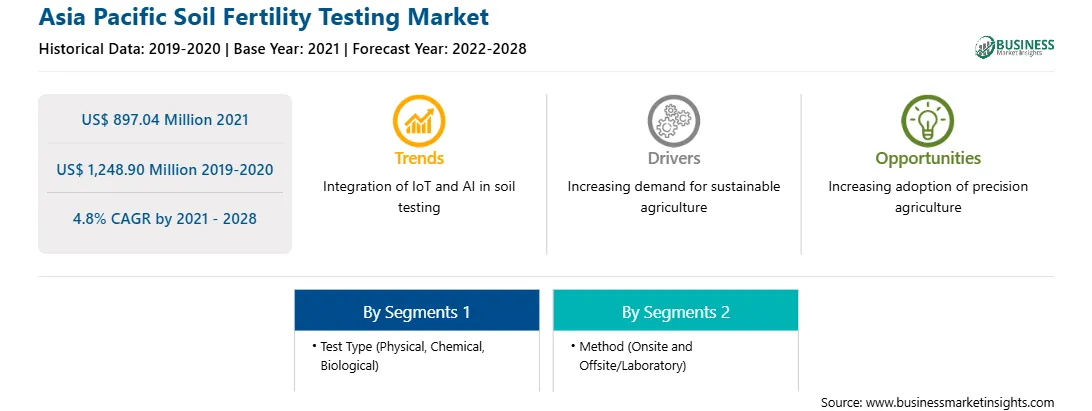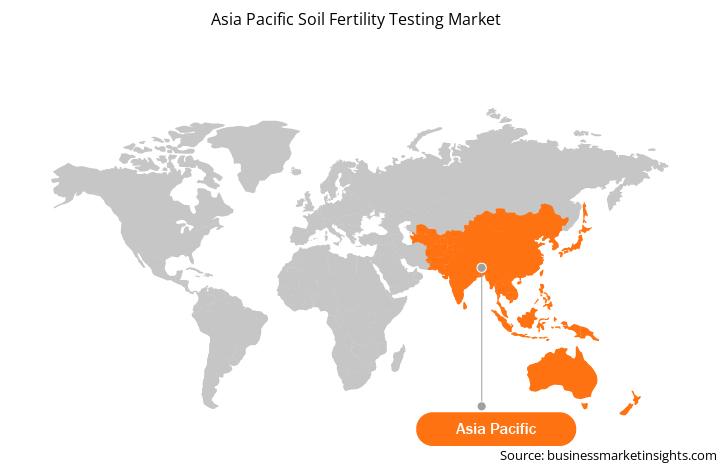Asia Pacific comprises of rapidly growing economies such as China, India, Japan, South Korea, and Australia. There are various regulations and government policies that are focusing on soil and nutrient management in the region. The Vision and Strategic Plan for ASEAN Cooperation in Food, Agriculture and Forestry (2016-2025) includes the following objectives – ensuring food security, better nutrition, and food safety; and increasing resilience and contributing to the mitigation of natural disasters, climate change, and other shocks. The divisions of implementation framework include technology packages, decision support systems, delivery systems, and regulatory functions. This framework promotes the use of soil fertility test kits as well as mobile labs that would provide on-the-spot soil fertility assessment services for soil-specific nutrient management. Asia Pacific is facing a major issue of excessive soil loss due to deforestation, agricultural development, and high pressure on soil, mainly caused by the expansion of urban areas and industrial sector. There are various factors under agricultural development, which is leading to soil pollution such as irrigation, agroplastics, the use of agrochemicals (pesticides and fertilizers), and the use of antibiotics and drugs in livestock production. Asia-Pacific is one of the regions having the largest land area and population, and it is also the world’s largest producer and consumer of agrochemicals such as pesticides and fertilizers. According to FAO (2017), the pesticide volumes used per hectare of agricultural land in Asia Pacific countries are above the global average. Moreover, farmers in these countries are using more fertilizers than the recommended quantities, which is due to the lack of knowledge regarding fertilization application rates. Such extensive consumption of agrochemicals is one of the major factors causing soil pollution. Thus, proper guidance can be provided to them by performing fertility tests on the soil from their fields, which is propelling the demand for soil fertility testing solutions and services in Asia Pacific.
The COVID-19 outbreak is anticipated to cause a significant economic loss in Asia-Pacific, especially in developing countries such as India. The consequences and impact can be even worse and totally depends on the spread of the virus. The governments of various Asia-Pacific countries are taking possible steps to restrict the spread of the virus by announcing lockdown, which has negatively impacted the revenue generated by the market. The governments have asked the manufacturers to delay their production which will adversely affect the agriculture sector. For instance, the three-week lockdown period in India coincided with the harvesting of rabi crops such as wheat, mustard, and pulses. Farmers did not have enough workers to harvest due to their relocation to their native lands. They had inadequate logistical support to market the products, and they experienced a lag in government minimum support price operations. This has hampered both pre-and post-harvest operations for the agricultural sector in India.

Strategic insights for the Asia Pacific Soil Fertility Testing provides data-driven analysis of the industry landscape, including current trends, key players, and regional nuances. These insights offer actionable recommendations, enabling readers to differentiate themselves from competitors by identifying untapped segments or developing unique value propositions. Leveraging data analytics, these insights help industry players anticipate the market shifts, whether investors, manufacturers, or other stakeholders. A future-oriented perspective is essential, helping stakeholders anticipate market shifts and position themselves for long-term success in this dynamic region. Ultimately, effective strategic insights empower readers to make informed decisions that drive profitability and achieve their business objectives within the market.

| Report Attribute | Details |
|---|---|
| Market size in 2021 | US$ 897.04 Million |
| Market Size by 2028 | US$ 1,248.90 Million |
| Global CAGR (2021 - 2028) | 4.8% |
| Historical Data | 2019-2020 |
| Forecast period | 2022-2028 |
| Segments Covered |
By Test Type
|
| Regions and Countries Covered | Asia-Pacific
|
| Market leaders and key company profiles |
The geographic scope of the Asia Pacific Soil Fertility Testing refers to the specific areas in which a business operates and competes. Understanding local distinctions, such as diverse consumer preferences (e.g., demand for specific plug types or battery backup durations), varying economic conditions, and regulatory environments, is crucial for tailoring strategies to specific markets. Businesses can expand their reach by identifying underserved areas or adapting their offerings to meet local demands. A clear market focus allows for more effective resource allocation, targeted marketing campaigns, and better positioning against local competitors, ultimately driving growth in those targeted areas.

The soil fertility testing market in Asia Pacific is expected to grow from US$ 897.04 million in 2021 to US$ 1,248.90 million by 2028; it is estimated to grow at a CAGR of 4.8% from 2021 to 2028. The application of fertilizers, especially the synthetic ones, leads to liberation of harmful gases into the atmosphere, which harms the environment. As a result, various countries have imposed several rules to prohibit the emission of such harmful gases into the atmosphere. For instance, the Food and Drug Administration (FDA) regulates domestic and imported food products that are marketed in interstate commerce; it ensures the safety, hygiene, nutritional content, wholesomeness of food as well as the appropriateness of product labels. In addition, the Agricultural Operations Regulation (2002) aims to address the problem of diffuse pollution caused by agricultural activities by ensuring the effective balance of phosphorus in the soil to preserve soil fertility and reduce losses from excessive manure application. The regulation also encompasses standards for livestock structure and manure management as well as land-use regulations to limit water pollution. Soil fertility testing provides information about soil health and proper nutrition required by crops, as well as information on chemicals applied to soil and their effects on the same. Soil contamination is projected to have a detrimental impact on the native ecology, including plants and humans. Toxic substances in the soil can degrade soil fertility and diminish soil yield. Such soils, if utilized to grow fruits and vegetables, the yield would lack critical nutrients and may contain dangerous compounds that can cause major health concerns. Moreover, at the time of export, crop nutritional values must be checked as they should meet the requirements set by various governments. Thus, soil fertility testing is significant to avoid such consequences by estimating soil fertility. Therefore, the stringent government regulations pertaining to the nutrient content of food products stimulates the soil fertility testing market growth.
In terms of test type, the chemical segment accounted for the largest share of the Asia Pacific soil fertility testing market in 2020. Further In term of method, the offsite/laboratory segment held a larger market share of the soil fertility testing market in 2020.
A few major primary and secondary sources referred to for preparing this report on the soil fertility testing market in Asia Pacific are company websites, annual reports, financial reports, national government documents, and statistical database, among others. Major companies listed in the report are SGS SA; Eurofins Scientific; ALS; Agrocares; and Polytest Laboratories among others.
The Asia Pacific Soil Fertility Testing Market is valued at US$ 897.04 Million in 2021, it is projected to reach US$ 1,248.90 Million by 2028.
As per our report Asia Pacific Soil Fertility Testing Market, the market size is valued at US$ 897.04 Million in 2021, projecting it to reach US$ 1,248.90 Million by 2028. This translates to a CAGR of approximately 4.8% during the forecast period.
The Asia Pacific Soil Fertility Testing Market report typically cover these key segments-
The historic period, base year, and forecast period can vary slightly depending on the specific market research report. However, for the Asia Pacific Soil Fertility Testing Market report:
The Asia Pacific Soil Fertility Testing Market is populated by several key players, each contributing to its growth and innovation. Some of the major players include:
The Asia Pacific Soil Fertility Testing Market report is valuable for diverse stakeholders, including:
Essentially, anyone involved in or considering involvement in the Asia Pacific Soil Fertility Testing Market value chain can benefit from the information contained in a comprehensive market report.